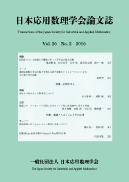
- Issue 4 Pages 127-
- Issue 3 Pages 53-
- Issue 2 Pages 33-
- Issue 1 Pages 1-
- |<
- <
- 1
- >
- >|
-
Hiroshi HIRAYAMA, Seiji KOMIYA2024Volume 34Issue 3 Pages 53-65
Published: 2024
Released on J-STAGE: September 26, 2024
JOURNAL FREE ACCESSAbstract. We propose a method to calculate the infinite interval oscillatory function integral $\int_0^\infty f(x)g(h(x))dx$ when $g(x)$ is an oscillatory function. By dividing $x=a$ into two and evaluating the integral over $[0,a]$ using numerical integration, the remainder is transformed to $t=h(x)$ and given the form $\int_{h(a)}^\infty F(t)g(t)dt$, which can then be expanded to an asymptotic series up to any order using partial integration and Taylor expansion. Calculations can be performed efficiently using this asymptotic expansion.
View full abstractDownload PDF (731K) -
Tomoya Miyashita, Shuhei Kudo, Yusaku Yamamoto2024Volume 34Issue 3 Pages 66-97
Published: 2024
Released on J-STAGE: September 26, 2024
JOURNAL FREE ACCESSAbstract. The matrix sign function has applications to the solution of the algebraic Riccati equation and to the computation of matrix eigenvalues. Recently, a new numerical algorithm for the matrix sign function based on the double-exponential integration formula has been proposed and has attracted attention due to its large-grain parallelism. In this paper, we give a new theoretical error bound for this method for the case of diagonalizable matrices and also propose two improvements to speed up the convergence and reduce the effect of rounding errors. We also report the parallel performance of the method.
View full abstractDownload PDF (2146K)
-
Shinsuke Kondo, Akitoshi Takayasu2024Volume 34Issue 3 Pages 98-126
Published: 2024
Released on J-STAGE: September 26, 2024
JOURNAL FREE ACCESSAbstract. This article introduces interval Chebyshev interpolation, which incorporates the concept of interval inclusion into the well-known Chebyshev interpolation for highprecision function approximation, and provides a methodology for rigorous numerical computation. Based on the concept of numerical computation with Chebyshev interpolation, as introduced by the MATLAB toolbox Chebfun, we present three numerical results of rigorous numerical computation using the Julia language: quadrature, the error function, and finding the maximum and minimum values of a given function.
View full abstractDownload PDF (1024K)
- |<
- <
- 1
- >
- >|